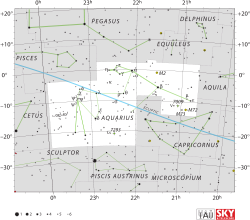86 Aquarii (abbreviated 86 Aqr) is a binary star[7] system in the equatorial constellation of Aquarius. 86 Aquarii is the Flamsteed designation, though it also bears the Bayer designation c1 Aquarii. It is faint but visible to the naked eye with an apparent visual magnitude of +4.47.[2] Based upon parallax measurements, the distance to this star is about 220 light-years (67 parsecs).[1]
| Observation data Epoch J2000 Equinox J2000 | |
|---|---|
| Constellation | Aquarius |
| Right ascension | 23h 06m 40.84483s[1] |
| Declination | –23° 44′ 35.2344″[1] |
| Apparent magnitude (V) | +4.47[2] |
| Characteristics | |
| Spectral type | G8 III[3] |
| U−B color index | +0.58[2] |
| B−V color index | +0.90[2] |
| Astrometry | |
| Radial velocity (Rv) | +15.2[4] km/s |
| Proper motion (μ) | RA: +58.86[1] mas/yr Dec.: –1.74[1] mas/yr |
| Parallax (π) | 15.08 ± 0.72 mas[1] |
| Distance | 220 ± 10 ly (66 ± 3 pc) |
| Details | |
| Surface gravity (log g) | 3.10[5] cgs |
| Temperature | 4,900[5] K |
| Metallicity [Fe/H] | –0.14[5] dex |
| Other designations | |
| Database references | |
| SIMBAD | data |
The two components of this system have an angular separation of 0.25 arcseconds.[7] The brighter component is a giant star with a spectral classification of G8 III[3] and an apparent magnitude of 4.79.[7] The effective temperature of its outer atmosphere is 4,900 K,[5] giving it the yellowish glow of a G-type star.[8] The fainter component is a star of magnitude 6.77.[7]
References
edit- ^ a b c d e f van Leeuwen, F. (November 2007), "Validation of the new Hipparcos reduction", Astronomy and Astrophysics, 474 (2): 653–664, arXiv:0708.1752, Bibcode:2007A&A...474..653V, doi:10.1051/0004-6361:20078357, S2CID 18759600.
- ^ a b c d Nicolet, B. (1978), "Photoelectric photometric Catalogue of homogeneous measurements in the UBV System", Astronomy and Astrophysics Supplement Series, 34: 1–49, Bibcode:1978A&AS...34....1N.
- ^ a b Houk, Nancy (1978), Michigan catalogue of two-dimensional spectral types for the HD stars, vol. 4, Ann Arbor: Dept. of Astronomy, University of Michigan, Bibcode:1988mcts.book.....H.
- ^ Wilson, Ralph Elmer (1953), "General Catalogue of Stellar Radial Velocities", Carnegie Institute Washington D.C. Publication, Washington: Carnegie Institution of Washington, Bibcode:1953GCRV..C......0W.
- ^ a b c d McWilliam, Andrew (December 1990), "High-resolution spectroscopic survey of 671 GK giants. I - Stellar atmosphere parameters and abundances", Astrophysical Journal Supplement Series, 74: 1075–1128, Bibcode:1990ApJS...74.1075M, doi:10.1086/191527.
- ^ "86 Aqr -- Star", SIMBAD, Centre de Données astronomiques de Strasbourg, retrieved 2012-07-13.
- ^ a b c d Eggleton, P. P.; Tokovinin, A. A. (September 2008). "A catalogue of multiplicity among bright stellar systems". Monthly Notices of the Royal Astronomical Society. 389 (2): 869–879. arXiv:0806.2878. Bibcode:2008MNRAS.389..869E. doi:10.1111/j.1365-2966.2008.13596.x. S2CID 14878976.
- ^ "The Colour of Stars", Australia Telescope, Outreach and Education, Commonwealth Scientific and Industrial Research Organisation, December 21, 2004, archived from the original on February 22, 2012, retrieved 2012-01-16
